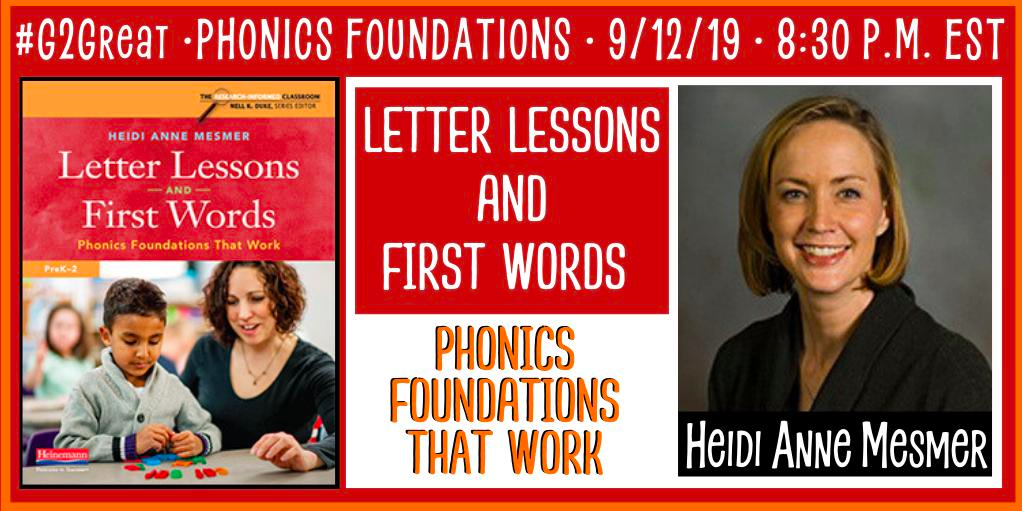
Thursday night, September 12, #g2great hosted Heidi Anne Mesmer to lead our chat about her book, Letter Lessons and First Words: Phonics Foundations That Work. This is a timely chat as there has been much for educators to read lately in regard to the “science of reading” debate. You can see the chat in its entirety on Wakelet here
Heidi’s book and our #g2great chat help to make clear some pivotal points about the teaching of phonics and its foundational work in growing young readers. Before we look at the specific discussion points from Thursday’s chat, I’d like to share some of Heidi’s recent work on phonics.
American Educator published an article by Heidi and Nell Duke in their winter 2018-2019 edition. In that article, Duke and Mesmer shared seven faux pas that teachers make when delivering phonics instruction:
- Spending Too Little or Too Much Time on Phonics Instruction
- Neglecting the Alphabetic Principle, Concept of Word in Print, Concepts in Print
- Teaching Letter Names without Letter Sounds
- Using Inappropriate Alphabet Key Words
- Lacking a Scope and Sequence
- Using a Problematic Approach to Teaching Sight Words
- Missing Essential Elements of Phonics Instructions–
- Specific Applicable Generalizations
- Active Construction and Deconstruction of Words
- Opportunities for Application
- Responsiveness
Heidi’s tweets and quotes taken directly from her book spoke to many of these issues in our #g2great chat on Thursday evening.
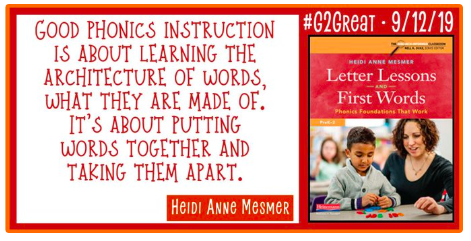
It’s critical for students to have daily opportunities to build words and take them apart. This practical application of their new letter sound knowledge helps them to understand how individual phonemes and letter combinations form words.
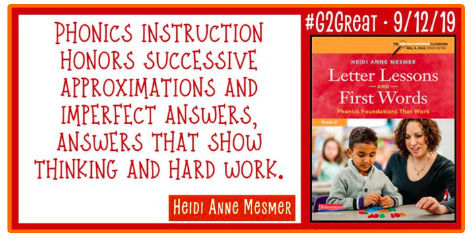
Emerging, early readers need a combination of direct instruction and repeated practice on their own to try out the new learning. Phonics teaching must include instruction, modeling and lots of authentic practice through reading and writing in order for students to become proficient.
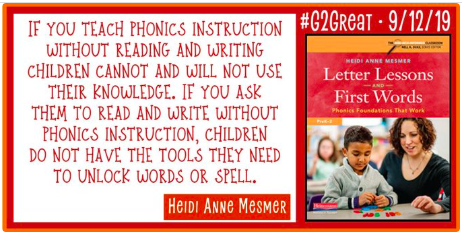
Heidi states that we must start by knowing what our students already know and what instruction they’ll need for decoding and encoding.

In Letter Lessons and First Words, Heidi reminds us that we must think back beyond our ability to read proficiently and embrace the importance of phonics instruction—
For a proficient adult reader, phonics can feel like a cumbersome distraction to the “real” work of reading and writing. But what this actually shows is that we’ve lost our awareness of what it is to be new to the printed word. As proficient readers, we read most words by sight and decoding is rarely a part of our reading and writing experience. Because phonics feels unnecessary to us, some teachers decide not to teach it or to give it only cursory attention. Others view it as necessary but don’t make the connection between phonics principles and real reading and writing. The latter kind of phonics instruction involves lifeless routines; odd, dreary activities; excessive repetition; or whole-group, scripted lessons that soar over the heads of some children and bore others. Instead of rejecting phonics outright, we might want to consider that it’s not phonics but how we teach it that is the problem. The teaching of phonics is a means to an end. Children need to decode in order to independently read and write. Phonics shouldn’t feel like an interruption or detour away from these authentic experiences. Phonics should be the building of a curiosity—developed by a passionate, informed teacher— about how words work, an inquiry about how the sounds of our language are mapped onto visual symbols. It is discovering the purpose of letters, how letters can work alone or be combined to symbolize sounds, and later in the journey, how the spelling of words quite often intersects with their meaning. Phonics instruction simply gives children the information about how letter–sounds work so that they can build automatic word recognition that frees their conscious attention to concentrate on meaning. (p. xiii)
Mesmer created the chart below which clarifies for teachers the research-based steps in a well-planned phonics lesson.
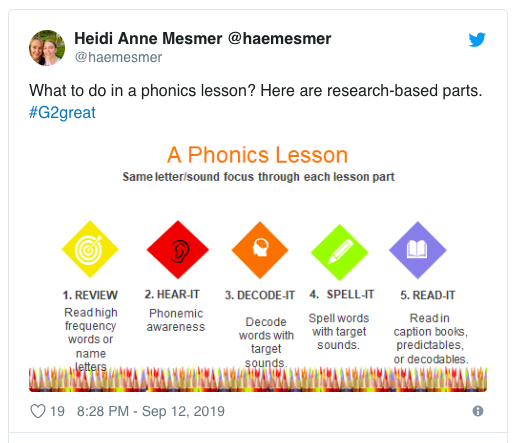
There is more to phonics instruction than a comprehensive program with teacher’s guide and mounds of consumables. Heidi lays out the critical components of phonics instruction.
Good phonics instruction is about learning the architecture of words—what they are made of. It’s about putting words together and taking them apart. Think about Legos and how children learn from assembling and disassembling. Words are the same way. To learn how they work, children must work with them, understand the parts, put them together, and take them apart. The best phonics instruction relies on active, manipulative, engaging activities in which students read and spell words. Children learn it by doing it. They should have dry erase boards to practice spelling words and listening for sounds. They should have magnetic letters for building words. They should have (child-safe) scissors that allow them to cut the words apart and put them back together. (p. xix)
In the midst of all the hype around reading instruction and various groups touting products, it is important that we return to the research around balanced instruction that includes teaching AND plenty of opportunity for children to use the basic elements of language in practical and authentic ways. The time spent in manipulating sounds and applying new knowledge of letter sound relationships to read and write is exactly what emerging readers need.
Thank you Heidi Anne Mesmer for your book and your support for our #g2great professionals. We know that together we can collaborate for a more effective and efficient way to teach our youngest readers.
American Federation of Teachers. (2019). Phonics Faux Pas. [online] Available at: https://www.aft.org/ae/winter2018-2019/duke_mesmer [Accessed 17 Sep. 2019].
Mesmer, H. (n.d.). Letter lessons and first words. (2019).